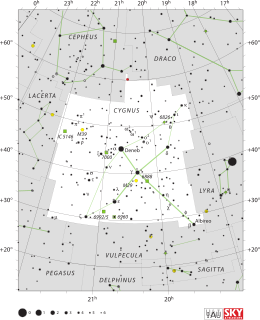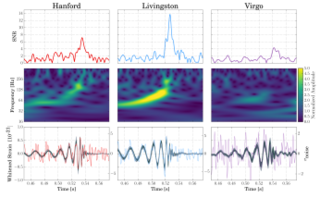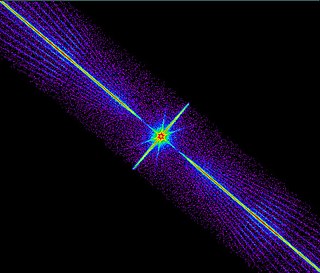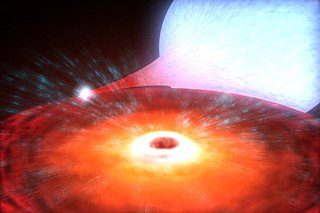 W
WA0620-00 is a binary star system in the constellation of Monoceros.
 W
WCygnus X-1 (abbreviated Cyg X-1) is a galactic X-ray source in the constellation Cygnus and was the first such source widely accepted to be a black hole. It was discovered in 1964 during a rocket flight and is one of the strongest X-ray sources seen from Earth, producing a peak X-ray flux density of 2.3×10−23 Wm−2 Hz−1 (2.3×103 Jansky). It remains among the most studied astronomical objects in its class. The compact object is now estimated to have a mass about 14.8 times the mass of the Sun and has been shown to be too small to be any known kind of normal star, or other likely object besides a black hole. If so, the radius of its event horizon has 300 km "as upper bound to the linear dimension of the source region" of occasional X-ray bursts lasting only for about 1 ms.
 W
WThe first direct observation of gravitational waves was made on 14 September 2015 and was announced by the LIGO and Virgo collaborations on 11 February 2016. Previously, gravitational waves had been inferred only indirectly, via their effect on the timing of pulsars in binary star systems. The waveform, detected by both LIGO observatories, matched the predictions of general relativity for a gravitational wave emanating from the inward spiral and merger of a pair of black holes of around 36 and 29 solar masses and the subsequent "ringdown" of the single resulting black hole. The signal was named GW150914. It was also the first observation of a binary black hole merger, demonstrating both the existence of binary stellar-mass black hole systems and the fact that such mergers could occur within the current age of the universe.
 W
WFuzzballs are theorized by some superstring theory scientists to be the true quantum description of black holes. The theory attempts to resolve two intractable problems that classic black holes pose for modern physics:The information paradox wherein the quantum information bound in in‑falling matter and energy entirely disappears into a singularity; that is, the black hole would undergo zero physical change in its composition regardless of the nature of what fell into it. The singularity at the heart of the black hole, where conventional black hole theory says there is infinite spacetime curvature due to an infinitely intense gravitational field from a region of zero volume. Modern physics breaks down when such parameters are infinite and zero.
 W
WGRO J1655-40 is a binary star consisting of an evolved F-type primary star and a massive, unseen companion, which orbit each other once every 2.6 days in the constellation of Scorpius. Gas from the surface of the visible star is accreted onto the dark companion, which appears to be a stellar black hole with several times the mass of the Sun. The optical companion of this low-mass X-ray binary is a subgiant F star.
 W
WGW151226 was a gravitational wave signal detected by the LIGO observatory on 25 December 2015 local time. On 15 June 2016, the LIGO and Virgo collaborations announced that they had verified the signal, making it the second such signal confirmed, after GW150914, which had been announced four months earlier the same year, and the third gravitational wave signal detected.
 W
WGW170104 was a gravitational wave signal detected by the LIGO observatory on 4 January 2017. On 1 June 2017, the LIGO and Virgo collaborations announced that they had reliably verified the signal, making it the third such signal announced, after GW150914 and GW151226, and fourth overall.
 W
WGW170608 was a gravitational wave event that was recorded on 8 June 2017 at 02:01:16.49 UTC by Advanced LIGO. It originated from the merger of two black holes with masses of and . The resulting black hole had a mass around 18 solar masses. About one solar mass was converted to energy in the form of gravitational waves.
 W
WGW170814 was a gravitational wave signal from two merging black holes, detected by the LIGO and Virgo observatories on 14 August 2017. On 27 September 2017, the LIGO and Virgo collaborations announced the observation of the signal, the fourth confirmed event after GW150914, GW151226 and GW170104. It was the first binary black hole merger detected by LIGO and Virgo together.
 W
WHR 6819, also known as HD 167128 or QV Telescopii, is a double or triple star system in the southern constellation of Telescopium. It is in the south-western corner of the constellation, near Pavo to the south and Ara to the west. The system appears as a variable star that is dimly visible to the naked eye with an apparent magnitude that ranges from 5.32 down to 5.39, which is comparable to the maximum brightness of the planet Uranus. It is about 1,120 light years from the Sun, and is drifting farther away at a rate of 9.4 km/s. Due to its location in the sky, it is visible only to observers south of 33°N latitude.
 W
WIGR J17091-3624 is a stellar mass black hole 28,000 light-years away. It lies in the constellation Scorpius in the Milky Way galaxy.
 W
WM33 X-7 is a black hole binary system in the galaxy M33. The system is made up of a stellar-mass black hole and a companion star. M33 X-7 is the largest known stellar black hole with an estimated mass of 15.65 times that of the Sun (M☉).[7] The total mass of the system is estimated to be around 85.7 M☉, which would make it the most massive black hole binary system.
 W
WSS 433 is one of the most exotic star systems observed. It is an eclipsing X-ray binary system, with the primary most likely a black hole, or possibly a neutron star. The spectrum of the secondary companion star suggests that it is a late A-type star. SS 433 is the first discovered microquasar. It is at the centre of the supernova remnant W50.
 W
WSwift J1745-26 is a stellar-mass black hole located a few degrees from the center of the Milky Way galaxy toward the constellation Sagittarius. It was discovered by NASA's Swift satellite on September 16, 2012 due to the detection of an X-ray nova. The pattern of X-rays from the nova indicated that the central object was a black hole. Its name arises from the coordinates of its sky position. While astronomers do not know its precise distance, they think the object resides about 20,000 to 30,000 light-years away in the galaxy's inner region. Ground-based observatories have detected infrared and radio emissions from Swift J1745-26, but thick clouds of obscuring dust have prevented astronomers from catching Swift J1745-26 in visible light.
 W
WV404 Cygni is a microquasar and a binary system in the constellation of Cygnus. It contains a black hole with a mass of about 9 M☉ and an early K giant star companion with a mass slightly smaller than the Sun. The star and the black hole orbit each other every 6.47129 days at fairly close range. Due to their proximity and the intense gravity of the black hole, the companion star loses mass to an accretion disk around the black hole and ultimately to the black hole itself. The "V" in the name indicates that it is a variable star, which repeatedly gets brighter and fainter over time. It is also considered a nova, because at least three times in the 20th century it produced a bright outburst of energy. Finally, it is a soft X-ray transient because it periodically emits short bursts of X-rays.
 W
WXTE J1118+480 is a low-mass X-ray binary in the constellation Ursa Major. It is a soft X-ray transient that most likely contains a black hole and is probably a microquasar.
 W
WXTE J1650-500 is a binary system containing a stellar-mass black hole candidate and 2000–2001 transient binary X-ray source located in the constellation Ara. In 2008, it was claimed that this black hole had a mass of 3.8±0.5 solar masses, which would have been the smallest found for any black hole; smaller than GRO 1655-40, the then known smallest of 6.3 MSun. However, this claim was subsequently retracted; the more likely mass is 5–10 solar masses.